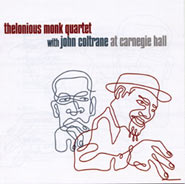Thelonious
Monk
Thelonious
Monk Quartet With John Coltrane At Carnegie Hall
(Blue
Note)
Maybe
the most ambitious - and the most successful - of those he has produced
up to now, the double LP titled That's The Way I Feel Now (1984) was
the tribute album that "producer-as-director" Hal Willner
dedicated to Thelonious Monk, the "Genius Of Modern Music"
who had died two years earlier. A stellar cast, by the way, with "famous
jazz people" (Carla Bley, Johnny Griffin, Barry Harris, Steve Lacy,
Elvin Jones, Gil Evans), "strange rockers" (NRBQ, Donald Fagen,
Was (Not Was), Todd Rundgren, Joe Jackson, Chris Spedding) and "some
people really impossible to pin down" (Dr. John, Gary Windo, John
Zorn, Schockabilly) all working hard in order to offer a personal interpretation
of the pianist's compositions. Compositions that an angular language,
a dry kind of lyricism and Monk's highly personal approach to the instrument
had made impossible to appreciate beyond a highly selective group of
peers, and whose highly innovative qualities are maybe best presented
in the concise length of the recordings he made in the late 40s and
early 50s now featured in the twin volumes titled Genius Of Modern Music
and in the two albums of solo piano performances that he recorded in
the 50s, Thelonious Himself (which curiously offers a trio performance
of Monk's Mood with John Coltrane and Wilbur Ware) and Alone In San
Francisco.
Who
knows who among the "non jazzers/non avant-gardists" of today
could possibly be featured on a (highly hypothetical) That's The Way
I Feel Now, Vol. II? Monk's compositions are quite hard to play well
(it's a well-known fact that during the sessions for the album Brilliant
Corners, which saw the participation of highly skilled musicians such
as Sonny Rollins and Max Roach, there were no complete takes; hence,
a meticulous splicing work by producer Orrin Keepnews), even if it's
true that highly developed playing skills by themselves do not necessarily
make for fantastic results (for instance, Six Monk's Compositions (1987),
the album that Anthony Braxton recorded at the end of the 80s, is not
a good example of a musician on the same wavelength as the compositions).
While "pretty adequate" performances of Monk's compositions
are - alas! - quite common, it's almost paradoxical that the best interpreter
of Monk was a saxophone player, the late Steve Lacy (in a sea of titles
I'd suggest two group efforts dating from the end of the 50s, Reflections
and The Straight Horn Of Steve Lacy; and two fantastic albums for solo
soprano saxophone which came out about thirty years later: Only Monk
and More Monk); it's also quite strange that some of the best Monk-like
results came from Europe: from the (so-called) "Dutch School"
aesthetics of Misha Mengelberg and the Instant Composers Pool (a good
specimen being the CD from the end of the 80s titled Two Programs -
The ICP Orchestra Performs Nichols - Monk); funny how the first version
of Epistrophy appearing on Thelonious Monk Quartet With John Coltrane
At Carnegie Hall so closely resembles the one I heard in concert a few
years ago, performed by a quartet of Misha Mengelberg, Michael Moore,
Ernst Glerum and Han Bennink.
The
release of Thelonious Monk Quartet With John Coltrane At Carnegie Hall
is to be applauded for two main reasons (the importance of both Monk
and Coltrane is to be taken for granted): the first one being that,
though they played together for more than a few months, not much was
recorded (only a few tracks in 1957 and 1958, which appeared on the
albums Thelonious Monk And John Coltrane and Monk's Music, besides the
already mentioned Monk's Mood on Thelonious Himself), every new appearance
being good news; the second reason is that the original concert was
recorded with crystal-clear clarity, which makes appreciating the quartet's
instrumental interplay quite easy. We also have a nice booklet with
useful news and six (brief) critical essays to help readers get a more
rounded picture.
The
quartet's performance took place on November 29, 1957. It was for a
benefit concert which also saw the presence of such names as Billie
Holiday, Dizzy Gillespie, Ray Charles, Chet Baker and Sonny Rollins.
Two performances, at 8.30 and Midnight (it's easy to hear the difference
in the atmosphere of the two quartet performances, which are also different
for the repertory played). Summer 1957 had seen the quartet playing
at the Five Spot Café; there, a Coltrane not yet too sure of
himself (and, obviously, not yet the innovator who will soon change
jazz so deeply) became fluent in the pianist's logic, as it's apparent
here both in the heads and the solos.
The
beautiful arpeggios of Monk's Mood make for a nice opening; we also
have an excellent performance of Crepuscule With Nellie, one of the
most beautiful compositions in the Monk canon; Coltrane's work is appropriately
fast on Evidence, Nutty and in the closing track, Epistrophy. Monk's
own work is excellent - maybe responding to a high-quality piano, his
"comping" a real joy. Nice rhythm section, with bass player
Ahmed Abdul-Malik working as an anchor and drummer Shadow Wilson playing
counterpoint to Monk's piano on bass and snare drums - listen to his
cymbal work on Epistrophy. The second performance is typical of a later
hour, with longer solos; here we have Bye-Ya, Sweet And Lovely, Blue
Monk and a shorter Epistrophy, all very good.
Beppe
Colli
©
Beppe Colli 2005
CloudsandClocks.net
| Oct. 6, 2005











